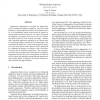Free Online Productivity Tools
i2Speak
i2Symbol
i2OCR
iTex2Img
iWeb2Print
iWeb2Shot
i2Type
iPdf2Split
iPdf2Merge
i2Bopomofo
i2Arabic
i2Style
i2Image
i2PDF
iLatex2Rtf
Sci2ools
SIBGRAPI
2009
IEEE
2009
IEEE
Learning Discriminative Appearance-Based Models Using Partial Least Squares
Appearance information is essential for applications such as tracking and people recognition. One of the main problems of using appearance-based discriminative models is the ambiguities among classes when the number of persons being considered increases. To reduce the amount of ambiguity, we propose the use of a rich set of feature descriptors based on color, textures and edges. Another issue regarding appearance modeling is the limited number of training samples available for each appearance. The discriminative models are created using a powerful statistical tool called Partial Least Squares (PLS), responsible for weighting the features according to their discriminative power for each different appearance. The experimental results, based on appearance-based person recognition, demonstrate that the use of an enriched feature set analyzed by PLS reduces the ambiguity among different appearances and provides higher recognition rates when compared to other machine learning techniques.
Appearance-based Discriminative Models | Computer Graphics | Discriminative Models | Issue Regarding Appearance | SIBGRAPI 2009 |
| Added | 21 May 2010 |
| Updated | 21 May 2010 |
| Type | Conference |
| Year | 2009 |
| Where | SIBGRAPI |
| Authors | William Robson Schwartz, Larry S. Davis |
Comments (0)

